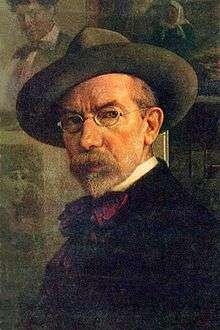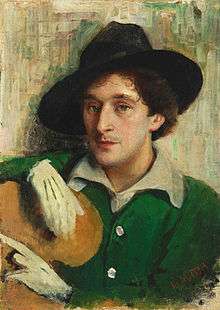Yehuda Pen

Yehuda Pen, also known as Yuri Pen (Yiddish: יודל פּען – Yudl Pen; 5 June 1854 in Zarasai, Lithuania – 1 March 1937 in Vitebsk, Belarus) was a Litvak painter and art teacher. He was a major figure of the Jewish Renaissance in Russian and Belarusian art at the beginning of 20th century.
Biography
Yehuda Pen was born on May 24 (June 5 Old Style) 1854 in the city of Novoalexandrovsk (now called Zarasai, or Ezhereni in Yiddish). He was orphaned at the age of thirteen and became an apprentice to a decorative painter in Dvinsk (now called Daugavpils, in Latvia). In 1879 he went to Saint Petersburg and took the entrance exam at the Imperial Academy of Fine Arts, but failed due to his lack of fluency in Russian. Despite lacking the necessary internal passport, he remained there and, in 1881, obtained permission to audit classes. His teachers included Pavel Chistyakov, Valentin Serov and Mikhail Vrubel. He was eventually admitted as a student and graduated in 1886.
He returned to Dvinsk for a time, then moved to Riga, where he became involved in the local artistic circles and met Ilya Repin, who had an estate along the Dvina that was a meeting place for the Peredvizhniki. In 1891, on his friends' advice, he settled in Vitebsk and, a year later, opened a private art school that was the first Jewish art school in Belarus. He catered to many poor students who were unable to gain admission to the larger academies; all they needed was a sponsor. Pen's pupils included Ilya Mazel, Yefim Minin, Oskar Meshchaninov, Marc Chagall, Ossip Zadkine, Leon Gaspard, and El Lissitzky. The school was in operation until 1919. At that time, thanks to the efforts of Chagall, he became a teacher at the Vitebsk Art School.
Pen was killed at his home in Vitebsk on the night of 28 February/1 March 1937. The exact circumstances of his death have never been clarified. He was buried in the Jewish cemetery there. The bronze bust on his grave has been stolen twice.
A gallery devoted to his works has been created in Vitebsk. His works are also kept at the Vitebsk Museum of Modern Art and the Belarusian National Arts Museum.
Gallery
 Letter from America, 1903
Letter from America, 1903 Old Tailor, 1910
Old Tailor, 1910 Reading a Newspaper, 1910s
Reading a Newspaper, 1910s Clockmaker, 1914
Clockmaker, 1914 Marc Chagall, c. 1915
Marc Chagall, c. 1915 Portrait of a Man, 1917
Portrait of a Man, 1917 House with a Goat, 1920s
House with a Goat, 1920s- Self-portrait with Muse and Death, 1925
 Talmudist, 1925
Talmudist, 1925 Breakfast, self-portrait, 1932
Breakfast, self-portrait, 1932 Petitioner
Petitioner
References
- Шишанов В. А. Витебский Музей современного искусства: история создания и коллекции. 1918—1941. Минск: Медисонт, 2007.
- Шишанов В. В неразобранном виде... // Витебский проспект. 2006. №2. 12 янв. p. 3.
- Шишанов В. Материалы о Ю.М.Пэне в РГАЛИ // Бюллетень Музея Марка Шагала. 2004. №2(12). pp. 5–11.
- Шишанов В. Об утраченном портрете Марка Шагала работы Юрия Пэна // Бюллетень Музея Марка Шагала. 2006. №14. pp. 110–111.
- Шишанов, В. Материалы о Ю. М. Пэне в РГАЛИ / В. Шишанов. // Малевич. Классический авангард. Витебск — 11: [альманах / ред. Т. Котович]. — Минск: Экономпресс, 2009. — pp. 42–55.
- Изобразительное искусство Витебска 1918 – 1923 гг. в местной периодической печати : библиограф. указ. и тексты публ. / сост. В. А. Шишанов. – Минск : Медисонт, 2010.
External links
| Wikimedia Commons has media related to Yehuda Pen. |